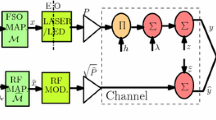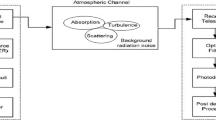Abstract
Most dominant and viable advanced technology for broadband wireless applications is free space communication (FSO) that provides unlicensed spectrum, very high data rate and has no electromagnetic interference. Atmospheric turbulences has great effect on FSO link and quality of light beam gets Detroit while propagating to long distance through the atmosphere. The signal exhibits a random fluctuation in the existence of atmospheric turbulence which degrades functioning of system. Bit Error Rate (BER), Outage Probability (OP) and Quality Factor are most important factors that decide quality of transmission of any data. Free space optical communication concept is introduced in this paper along with its issues, challenges and heuristic solutions. The findings in the paper demonstrate deployment of different methods for enhancing the system performance. It is seen that by using heuristic solutions such as FSO-WDM, hybrid RF/FSO better results with respect to BER can be obtained in comparison to simple FSO for high speed wireless communication.
Access this chapter
Tax calculation will be finalised at checkout
Purchases are for personal use only
Similar content being viewed by others
References
Kaur, G., Singh, H.: Simulative Investigation of 32x5 Gb/s DWDM-FSO system using semiconductor optical amplifier under different weather conditions. Int. J. Adv. Res. Comput. Sci. 8(4), 392–397 (2017)
Mazin, A.A.A.: Performance analysis of WDM-FSO link under turbulence channel. World Sci. News 50, 160–173 (2016)
Elgala, H., Mesleh, R., Haas, H.: Indoor optical wireless communication: potential and state-of-the-art. IEEE Commun. Mag. 49(9), 56–62 (2011). https://doi.org/10.1109/mcom.2011.6011734
Esmail, M.A., Ragheb, A., Fathallah, H., Alouini, M.S.: Investigation and demonstration of high speed full-optical hybrid FSO/fiber communication system under light sand storm condition. IEEE Photon. J. 9(1) (2017). Article no. 7900612
Khalighi, M.A., Uysal, M.: Survey on free space optical communication: a communication theory perspective. IEEE Commun. Surv. Tutors. 16(4), 2231–2258 (2014)
Ghassemlooy, Z., Popoola, W., Rajbhandari, S.: Optical Wireless Communications: System and Channel Modeling with Matlab. CRC Press Taylor and Francis Group, Boca Raton (2013)
Luong, D.A., Truong, C.T., Pham, A.T.: Effect of APD and thermal noises on the performance of SC-BPSK/FSO systems over turbulence channels. In: 18th Asia-Pacific Conference on Communications (APCC), pp. 344–349 (2012)
Ramirez-Iniguez, R., Idrus, S.M., Sun, Z.: Atmospheric transmission limitations. In: Optical Wireless Communications: IR for Wireless Connectivity, p. 40. Taylor & Francis Group, LLC, London (2008)
Li, J., Liu, J.Q., Taylor, D.P.: Optical communication using subcarrier PSK intensity modulation through atmospheric turbulence channels. IEEE Trans. Commun. 55, 1598–1606 (2007)
Popoola, W.O., Ghassemlooy, Z.: BPSK subcarrier intensity modulated free space optical communication in atmospheric turbulence. J. Light Wave Technol. 27, 967–973 (2009)
Fried, D.L.: Optical heterodyne detection of an atmospherically distortion wave front. Proc. IEEE 55, 57–77 (1967)
Alkholidi, A., Altowij, K.: Effect of clear atmospheric turbulence on quality of free space optical communications in Western Asia. In: Das, N. (ed.) Optical Communications Systems (2012)
Majumdar, A.K., Ricklin, J.C.: Free Space Laser Communications: Principles and Advances. Springer, Heidelberg (2008). ISBN-13 978-0-387-28652-5
Andrews, L.: Atmospheric Optics. SPIE Optical Engineering Press, Bellingham (2004)
Andrews, L., Phillips, R., Hopen, C.: Laser Beam Scintillation with Applications. SPIE Optical Engineering Press, Bellingham (2001)
Gagliardi, R., Karp, S.: Optical Communications. Wiley, New York (1995)
Kim, I., Mcarthur, B., Korevaar, E.: Comparison of laser beam propagation at 785 and 1550 nm in fog and haze for optical wireless communications. In: Proceedings of SPIE, vol. 4214, pp. 26–37 (2001)
Akiba, M., Ogawa, K., Walkamori, K., Kodate, K., Ito, S.: Measurement and simulation of the effect of snow fall on free space optical propagation. Appl. Opt. 47(31), 5736–5743 (2008)
Achour, M.: Simulating free space optical communication; part I, rain fall attenuation. In: Proceedings of SPIE, vol. 3635 (2002)
Bouchet, O., Marquis, T., Chabane, M., Alnaboulsi, M., Sizun, H.: FSO and quality of service software prediction. In: Proceedings of SPIE, vol. 5892, pp. 1–12 (2005)
Niaz, A., Qamar, F., Ali, M., Farhan, R., Islam, M.K.: Performance analysis of chaotic FSO communication system under different weather conditions. Trans. Emerg. Telecommun. Technol. (2019). https://onlinelibrary.wiley.com/doi/abs/10.1002/ett.3486
Sarangal, H., Singh, A., Malhotra, J., Thapar, S.S.: Performance evaluation of hybrid FSO-SACOCDMA system under different weather conditions. J. Opt. Commun. (2018). https://doi.org/10.1515/joc-2018-0172
Chatzidiamantis, N.D., Karagiannidis, G.K., Kriezis, E.E., Matthaiou, M.: Diversity combining in hybrid RF/FSO systems with PSK modulation. In: IEEE International Conference on Communications (2011)
Nadeem, F., Kvicera, V., Awan, M.S., Leitgeb, E., Muhammad, S.S., Kandus, G.: Weather effects on hybrid FSO/RF communication link. IEEE J. Sel. Areas Commun. 27(9), 1687–1697 (2009)
Ghoname, S., Fayed, H.A., El Aziz, A.A., Aly, M.H.: Performance evaluation of an adaptive hybrid FSO/RF communication system: impact of weather attenuation. Iran. J. Sci. Technol. Trans. Electr. Eng. (2019). https://doi.org/10.1007/s40998-019-00244-0
Alma, H., Al-Khateeb, W.: Effect of weather conditions on quality of free space optics links (with focus on Malaysia). In: 2008 International Conference on Computer and Communication Engineering, Kuala Lumpur, pp. 1206–1210 (2008). https://doi.org/10.1109/ICCCE.2008.4580797
Chaudhary, S., Amphawan, A.: The role and challenges of free-space systems. J. Opt. Commun. 35, 327–334 (2014). https://doi.org/10.1515/joc-2014-0004
Kim, I.I., Korevaar, E.: Availability of free space optic (FSO) and hybrid FSO/RF systems. Light pointe Tech report. http://www.opticalaccess.com
Kaushal, H., Kaddoum, G.: Optical communication in space: challenges and mitigation techniques. IEEE Commun. Surv. Tutor. https://doi.org/10.1109/comst.2016.2603518
Sarkar, D., Metya, S.K.: Effects of atmospheric weather and turbulence in MSK based FSO communication system for last mile users. Telecommun. Syst. (2019). https://doi.org/10.1007/s11235-019-00602-7
Singh, N.: To analyze the aftermath of using hybrid RF/FSO link over FSO link under various turbulence of atmosphere. Int. J. Eng. Res. Technol. (IJERT) 8(05) (2019). http://www.ijert.org, ISSN 2278-0181 IJERTV8IS050421 (This work is licensed under a Creative Commons Attribution 4.0 International License)
Majumdar, A.K., Ricklin, J.C.: Free-Space Laser Communications Principles and Advances. Springer, New York (2008)
David, F.: Scintillation loss in free-space optic systems. In: LASER 2004, San Jose, USA, vol. 5338 (2004)
Henniger, H., Wilfert, O.: An introduction to free space optical communications. Radio Eng. 19(2), 203–212 (2010)
Author information
Authors and Affiliations
Corresponding author
Editor information
Editors and Affiliations
Rights and permissions
Copyright information
© 2020 Springer Nature Switzerland AG
About this paper
Cite this paper
Rai, S., Garg, A.K. (2020). FSO: Issues, Challenges and Heuristic Solutions. In: Smys, S., Tavares, J., Balas, V., Iliyasu, A. (eds) Computational Vision and Bio-Inspired Computing. ICCVBIC 2019. Advances in Intelligent Systems and Computing, vol 1108. Springer, Cham. https://doi.org/10.1007/978-3-030-37218-7_122
Download citation
DOI: https://doi.org/10.1007/978-3-030-37218-7_122
Published:
Publisher Name: Springer, Cham
Print ISBN: 978-3-030-37217-0
Online ISBN: 978-3-030-37218-7
eBook Packages: Intelligent Technologies and RoboticsIntelligent Technologies and Robotics (R0)




